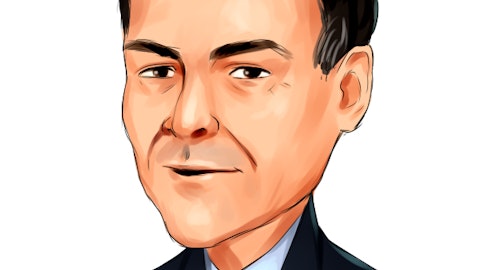Our extensive research has shown that imitating the smart money can generate significant returns for retail investors, which is why we track more than 700 prominent money managers and analyze their quarterly 13F filings. The stocks that are heavily bought by hedge funds historically outperformed the market, though there is no shortage of high profile gigantic failures like hedge funds’ recent losses in Valeant. Let’s take a closer look at what the funds we track think about Micron Technology, Inc. (NASDAQ:MU) in this article.
Is Micron Technology, Inc. (NASDAQ:MU) an excellent stock to buy now? Hedge funds are selling. The number of bullish hedge fund bets decreased by seven lately. MU was in 64 hedge funds’ portfolios at the end of the fourth quarter of 2015. There were 71 hedge funds in our database with MU positions at the end of the previous quarter. At the end of this article we will also compare MU to other stocks, including Weyerhaeuser Company (NYSE:WY), Molson Coors Brewing Company (NYSE:TAP), and Republic Services, Inc. (NYSE:RSG) to get a better sense of its popularity.
Follow Micron Technology Inc (NASDAQ:MU)
Follow Micron Technology Inc (NASDAQ:MU)
Receive real-time insider trading and news alerts
To most market participants, hedge funds are viewed as underperforming, old financial tools of yesteryear. While there are over 8000 funds in operation at present, We look at the top tier of this group, approximately 700 funds. These money managers administer the lion’s share of all hedge funds’ total capital, and by tracking their highest performing picks, Insider Monkey has uncovered many investment strategies that have historically exceeded Mr. Market. Insider Monkey’s small-cap hedge fund strategy outstripped the S&P 500 index by 12 percentage points per annum for a decade in their back tests.
One of Micron’s long-term shareholders was billionaire David Einhorn’s Greenlight Capital, which unloaded the position after the stock tumbled during the third quarter of 2015. In this way, during the fourth quarter, Greenlight sold around 12.37 million shares and closed the position. Prior to that, the investor had been quite bullish on the stock and discussed Micron in several of its letters to investors. On the other hand, Whitney Tilson’s T2 Partners saw the drop in the third quarter as an opportunity to buy and further increased its stake between July and September. On the next page, we are going to take a closer look at the last comments both investors made about Micron.
“MU was our biggest winner in 2014. Unfortunately, we overstayed our welcome and gave back much of those gains this year. The shares peaked at over $36 last December before collapsing to $14.98 on September 30. Our thesis has been that MU’s primary product, DRAM, has consolidated to three players, who are likely to create more industry profits compared to when DRAM production was highly fragmented.
The problem is that structural industry improvement doesn’t make DRAM less cyclical. The large capital requirements force participants to make large investments in anticipation of future demand. If the industry overestimates demand, it still makes sense to operate at full capacity and oversupply ensues. This year, demand came up short, DRAM prices collapsed, and despite our concerns about PC demand, we missed the turn of the cycle. Those PC demand worries led us to sell LAM Research and Marvell Technology at good prices prior to a sell-off in each security and we shorted (and subsequently covered) Best Buy, IBM and Intel. Although all of these moves helped, we underestimated the extent of MU’s exposure to the PC demand shortfall.
MU’s other business is flash memory or NAND. We anticipated a significant recovery in NAND this year that failed to materialize. MU is set to earn far less than we expected, and earnings will remain low until supply and demand come into balance.
Two other problems with our thesis have emerged. First, the Chinese have expressed interest in getting into DRAM. Our prior view was that the consolidated industry would not face new entrants. While the Chinese threat is distant, we judge it relevant. Second, MU announced a much more aggressive capital spending plan for NAND than we envisioned. While management believes that the extra investment will generate adequate returns, we are unconvinced. With separate problems clouding both the short-term and long-term, we determined that there is enough risk to the thesis to reduce the position.
The three large problem positions tell only a part of the portfolio story. The trouble started toward the end of the second quarter. In early June we were up a little for the year, which wasn’t exciting, but we were about even with the market. We had noted it was hard to find things to buy. Then, between June 4 and August 18, we lost more than 14% (41 losing days and 13 winning days) in a flat market. It was a period where cheap stocks got cheaper and expensive stocks became ever dearer.
Notably, we suffered most of our losses prior to the market decline that commenced in late August. As the market fell, our portfolio performed only slightly worse than we would have expected. Our shorts fell almost as much as our longs and we lost only a little more than our net exposure during the correction,” Greenlight said.
Whitney Tilson’s Kase Fund (T2 Partners) held around 181,420 shares of Micron at the end of September, up by 32% on the quarter. The investor did not file a 13F filing for the end of the fourth quarter of 2015. In its third-quarter letter to investors, Tilson said:
‘”I wrote about why I liked Micron in last quarter’s letter, but I was too early, as the stock has fallen another 20%. I don’t think it’s too early anymore and I recently added to our position.
The company reported dismal earnings on Thursday and gave weak guidance for next quarter, yet the stock rose 7.7% on Friday because expectations – and the stock price – were so low. This is the kind of stock I like to own: one that is almost impervious to bad news, but will soar on any hint of good news.
The stock is stupidly cheap at ~4x the company’s potential earnings power in a good environment (which I estimate at $4/share), a 40% discount to the replacement value of its manufacturing facilities, and 24% below a lowball $21 bid by a Chinese state-owned chip design company, Tsinghua Unigroup Ltd.
While short-term demand for DRAM chips is weak and Micron’s costs are elevated due to the need to upgrade its manufacturing plants, the two key pillars of my investment thesis remain intact: 1) continued strong (20%+) underlying growth in long-term demand; and 2) rational industry behavior (i.e., restrained capacity growth), the combination of which should lead to solid pricing and healthy profits over time. Those last two words – “over time” – are important, however, because while the economic characteristics of the industry have improved markedly, it remains cyclical (as we’re seeing now).”
Keeping this in mind, we’re going to take a look at the latest action surrounding Micron Technology, Inc. (NASDAQ:MU).
What have hedge funds been doing with Micron Technology, Inc. (NASDAQ:MU)?
At Q4’s end, a total of 64 of the hedge funds tracked by Insider Monkey were bullish on this stock, a decline of 10% from one quarter earlier. With hedgies’ capital changing hands, there exists a few notable hedge fund managers who were boosting their stakes significantly (or already accumulated large positions).
Of the funds tracked by Insider Monkey, Peter Rathjens, Bruce Clarke and John Campbell’s Arrowstreet Capital has the biggest position in Micron Technology, Inc. (NASDAQ:MU), worth close to $233.4 million, corresponding to 1.1% of its total 13F portfolio. The second largest stake is held by David Cohen and Harold Levy’s Iridian Asset Management, with a $161.8 million position; the fund has 1.3% of its 13F portfolio invested in the stock. Other members of the smart money that are bullish, encompass David Harding’s Winton Capital Management, John Overdeck and David Siegel’s Two Sigma Advisors and Ross Margolies’s Stelliam Investment Management.
Seeing as Micron Technology, Inc. (NASDAQ:MU) has faced a declination in interest from the entirety of the hedge funds we track, it’s safe to say that there exists a select few hedge funds who were dropping their full holdings last quarter. It’s worth mentioning that David Einhorn’s Greenlight Capital dumped the largest position of the “upper crust” of funds followed by Insider Monkey, comprising an estimated $185.3 million in stock. Joel Greenblatt’s fund, Gotham Asset Management, also cut its stock, about $56.4 million worth. These transactions are intriguing to say the least, as total hedge fund interest was cut by seven funds last quarter.
Let’s check out hedge fund activity in other stocks – not necessarily in the same industry as Micron Technology, Inc. (NASDAQ:MU) but similarly valued. These stocks are Weyerhaeuser Company (NYSE:WY), Molson Coors Brewing Company (NYSE:TAP), Republic Services, Inc. (NYSE:RSG), and Telefonica Brasil SA (ADR) (NYSE:VIV). This group of stocks’ market values are closest to MU’s market value.
| Ticker | No of HFs with positions | Total Value of HF Positions (x1000) | Change in HF Position |
|---|---|---|---|
| WY | 21 | 1088193 | -9 |
| TAP | 53 | 3063867 | -17 |
| RSG | 21 | 429946 | -9 |
| VIV | 12 | 94350 | -1 |
As you can see these stocks had an average of 27 hedge funds with bullish positions and the average amount invested in these stocks was $1.17 billion. That figure was $1.32 billion in MU’s case. Molson Coors Brewing Company (NYSE:TAP) is the most popular stock in this table. On the other hand Telefonica Brasil SA (ADR) (NYSE:VIV) is the least popular one with only 12 bullish hedge fund positions. Compared to these stocks Micron Technology, Inc. (NASDAQ:MU) is more popular among hedge funds. Considering that hedge funds are fond of this stock in relation to its market cap peers, it may be a good idea to analyze it in detail and potentially include it in your portfolio.
Disclosure: none





